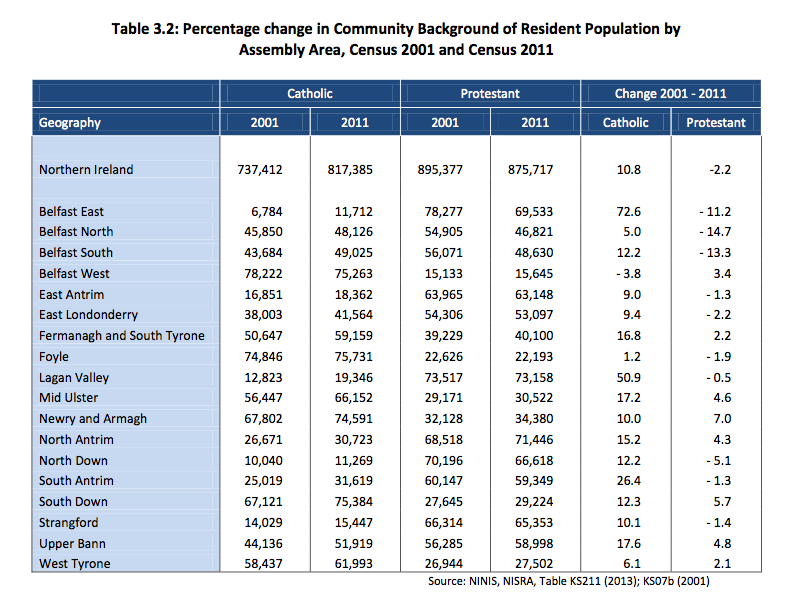New figures released this week from the 2011 Census suggest that the Catholic population of the North is set to grow at the expense of the Protestant population.
In December last year the Census was published, revealing that the Protestant population of Northern Ireland now stood at 48 per cent, while the Catholic population was at 45 per cent. This was the first time that the Protestant population had fallen below 50 per cent, a decline of some ten per cent in twenty years.
On Monday new figures were released comparing the 18 Assembly constituencies for Northern Ireland, which showed the Protestant population is still more likely to be older than the Catholic population, while there is a distinct geographical split between the places where each of the two communities is in a majority.
The figures confirm that Protestants are in a majority in the east of Northern Ireland, with the exception of Belfast, while Catholics are in a majority in the west and south.
The new Census stats also find that the largest percentage increase in the number of residents from a Catholic community background occurred in Belfast East (73 per cent), followed by Lagan Valley (51 per cent) and South Antrim (26 per cent). There are also significant falls in the Protestant count over the past decade in three of the Belfast constituencies, namely: Belfast North (15 per cent), Belfast South (13 per cent) and Belfast East (11 per cent).
It is also estimated that 95,000 Protestants and 46,000 Catholics died between 2001 and 2011. There was a total of 89,000 Protestant births and 118,000 Catholic births over the same period.
Drilling down to constituency level, when it comes to national identity there are strong parallels with religious affiliation.
The Assembly constituencies with the highest proportions of residents who had a British Only national identity were Strangford, followed by Belfast East, East Antrim and North Down; those with the lowest proportion were Belfast West, Foyle and Newry and Armagh.
The highest prevalence rates for Irish Only as a national identity were found in Belfast West, Foyle and Newry and Armagh, while the lowest rates were recorded in North Down, Strangford and Belfast East.
Residents in West Tyrone (27 per cent), South Down (26 per cent) and Mid Ulster (25 per cent) were most likely to have a Northern Irish Only national identity, while those living in Belfast East (17 per cent), Lagan Valley and Belfast West (both 18 per cent) were least likely.
So how does West Belfast shape up? Here’s the good, the bad and downright ugly:
Only two Assembly Areas, Belfast North and Belfast West, saw a fall in population during the decade, while the remaining Assembly Areas experienced a population increase.
The only constituency which saw a fall in Catholic population was Belfast West (-3.8%).
Belfast South, Belfast West and Foyle had the largest proportions of single people.
The highest proportion of residents from a Catholic community background were Belfast West (80 per cent), Foyle (75 per cent), and South Down (69 per cent).
Belfast West (27 per cent) and Belfast North (26 per cent) had the highest prevalence of long-term health issues.
Belfast West, Belfast North and West Tyrone were most likely to have no qualifications.
Belfast West (28 per cent), Foyle (29 per cent), and West Tyrone (31 per cent) had the lowest levels of full-time employment.
Part-time working was most prevalent in Belfast West (15 per cent), Belfast North and South Antrim (both 14 per cent).
Unemployment was highest in Foyle (7.6 per cent), Belfast West (7 per cent) and Belfast North (6.3 per cent).
The prevalence of driving to work is lowest in Belfast West and Belfast North.
The average age was highest in North Down (42 years) and East Antrim/ Strangford (both 40 years) while the lowest was in Belfast South and Belfast West (both 33 years, although Belfast South is skewed by its large student population).
Belfast West contains the highest proportion of lone parent households (19 per cent).
Some ability in Irish was most common in Belfast West (21 per cent).
Some ability in Ulster-Scots was lowest in Belfast West (2.5 per cent).
The largest proportion of Irish speakers are residing in Belfast West (1.4 per cent).
In Belfast West, almost a quarter of households (24 per cent) rent from the NIHE.
Households in housing association accommodation are most prevalent in Belfast North (8.9 per cent), Belfast West (8.7 per cent) and Foyle (6.4 per cent).
Gas central heating was most likely to be used as the sole means of central heating by households in the Greater Belfast area, particularly Belfast West (48 per cent) and Belfast North (47 per cent).






